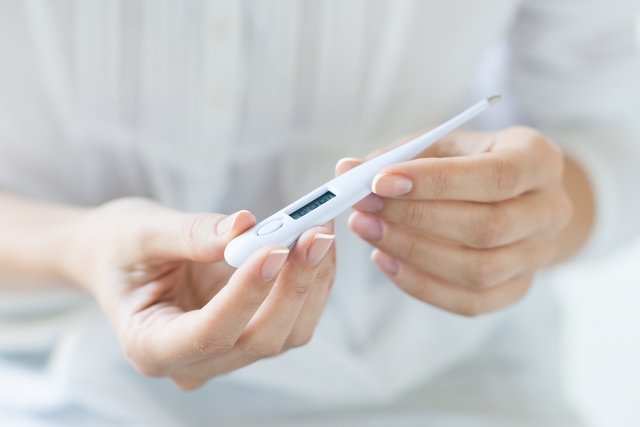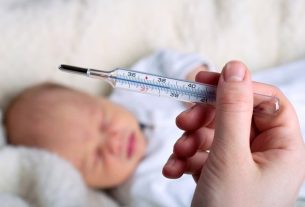It is considered a fever when the axillary temperature is above 38ºC, however some people may start to feel feverish when the temperature is still close to 37.5ºC.
The safest way to know if you have a fever is to use a thermometer to measure your body temperature, and not rely solely on symptoms or homemade ways of measuring temperature, such as placing your hand on your forehead or the back of your neck.
Often, the fever can be reduced naturally, by removing an item of clothing or taking a bath with warm water, for example. However, in cases where the temperature in the armpit is higher than 39ºC (high fever) it is recommended to seek medical attention, as the use of medication may be necessary. See the main ways to lower your fever.
Normal body temperature
Normal body temperature varies between 35.4ºC and 37.4ºC, when measured in the armpit. This means that temperatures below 35.4ºC may indicate hypothermia, while temperatures above 37.4ºC may indicate the onset of a fever.
How to know if you have a fever
To find out if your temperature is normal or if it is a fever, please enter the value into our calculator:
How many degrees is a fever?
A fever is considered when the axillary temperature is above 38ºC, however, the temperature can be classified in different ways:
- Slightly increased (subfebrile or feverish): 37.5ºC to 37.9ºC. In these cases, other symptoms usually appear, such as chills, tiredness, tremors or redness of the face;
- Fever: 38ºC or higher;
- High fever: above 39ºC. It should be considered a medical emergency and therefore you should go to the hospital.
In babies and children, where temperature measurement in the anal region is more common, fever should be considered from 37.8º C.
Is 37º or 37.5ºC a fever?
Having a temperature of 37º or 37.5ºC is not considered a fever, it is just an indication that the body is slightly warmer than normal, which can happen due to wearing very warm clothes or staying in the sun for a long time, for example.
However, temperatures above 37.5ºC may indicate the beginning of an infectious or inflammatory process. Therefore, it is recommended that the temperature be monitored throughout the day to see if it increases, especially if other symptoms such as pain, cough or general discomfort appear.
How to measure temperature correctly
To measure body temperature correctly, it is first important to know how to use each type of thermometer. The most common are:
- Digital thermometer: place the metal tip in the armpit, anus or mouth in direct contact with the skin or mucous membranes and wait until the beep sounds to check the temperature;
- Glass thermometer: place the tip of the thermometer in the armpit, mouth or anus, in direct contact with the skin or mucous membranes, wait 3 to 5 minutes and then check the temperature;
- Infrared thermometer: Point the tip of the thermometer at your forehead or inside your ear canal and press the button. After the “beep” the thermometer will show the temperature immediately.
Body temperature should be measured at rest and never immediately after physical activity or after a shower, because in these cases it is normal for the temperature to be higher and, therefore, the value may not be real.
How to measure baby’s temperature
A baby’s body temperature should be measured with a thermometer, as in an adult, and preference should be given to more comfortable and faster thermometers, such as digital or infrared.
The ideal place to assess the baby’s temperature more accurately is the anus and, in these cases, a digital thermometer with a soft tip should be used to avoid hurting the baby. However, if parents do not feel comfortable, they can use the armpit temperature measurement, confirming the anal temperature only at the pediatrician, for example.
What to do to reduce the fever
There are some natural ways to lower body temperature and relieve fever, such as removing excess clothing, taking a warm bath or applying cold compresses to the forehead and face. See other natural ways to reduce fever.
However, depending on the cause, there are cases in which it is necessary to use medication. The most commonly used medicine to reduce fever is paracetamol, which can be taken up to 3 times a day, at intervals of 6 to 8 hours. The dosage of paracetamol should always be indicated by a doctor, especially in the case of children, as it varies according to body weight. Find out more about fever-reducing medications.
Bibliography
- NHS. High temperature (fever) in adults. Available at: <https://www.nhs.uk/conditions/fever-in-adults/>. Accessed on June 19, 2020
- POTTER, Patricia A.; PERRY, Anne G.. Fundamentals of Nursing. 9.ed. Rio de Janeiro: Elsevier, 2017. 205-217.

Sign up for our newsletter and stay up to date with exclusive news
that can transform your routine!
Warning: Undefined array key "title" in /home/storelat/public_html/wp-content/plugins/link-whisper-premium/templates/frontend/related-posts.php on line 12
Warning: Undefined array key "title_tag" in /home/storelat/public_html/wp-content/plugins/link-whisper-premium/templates/frontend/related-posts.php on line 13




